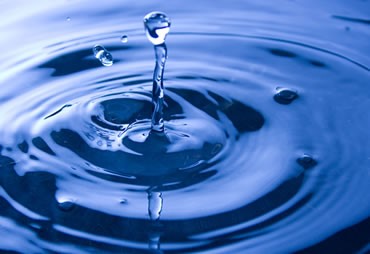
General Facts:
- Water has three forms: solid (ice), liquid (water), and gas (air).
- The boiling point for pure water is 100° C (212° F).
- The freezing/melting point for pure is 0° C (32° F).
- Pure water has a neutral pH of 7, which is neither acidic nor basic.
- Water dissolves more substances than any other liquid.
Water on Earth:
- Between 70 and 75% of the earth’s surface is covered with water.
- The earth is a closed system meaning that it rarely loses or gains extra matter. The same amount of water that existed on the earth millions of years ago is still present today.
- The total amount of water on the earth is about 326 million cubic miles of water.
Water is believed to be the most important chemical necessary for life. Earth has a breathable atmosphere partially due to the existence of water. Water contains the oxygen needed for life. Water doesn’t burn skin (like liquids containing acids do), it is drinkable, and it allows life-providing molecules to move around easily. Water vapor can be stored in the atmosphere and be delivered as rain across the planet. Our oceans help regulate the planet’s climate, absorb heat in the summer, and release it during the winter. Our oceans also serve as a home for countless plants and animals.
Water promotes life in numerous other ways. It allows us to grow crops, keep livestock, and wash our food. Water has advanced civilization by providing a means for travel and a source of power for factories.
Water in Humans:
- Roughly 70% of an adult’s body is made up of water.
- At birth, roughly 80% of an infant’s body weight is water.
- Amniotic fluid*, the colorless liquid that surrounds the baby in utero, is 99% water.
- Every system in your body depends on water.
- 75% of the human brain is water.
- 70% of your skin is water.
- Water flushes toxins out of vital organs, carries nutrients to your cells, regulates body temperature, aids our metabolism, and provides a moist environment for ear, nose and throat tissues.
- Every day you lose water: through your breath, perspiration, urine and bowel movements.
- By the time a person feels thirsty, his or her body has lost over 1% of its total water amount.
- The weight a person loses directly after intense physical activity is weight from water, not fat.
- A person can live more than a month without food, but only about a week without water.
- The Institute of Medicine determined that an adequate intake for men is roughly 3 liters (about 13 cups), and for women 2.2 liters (about 9 cups) of total beverages a day.
*Amniotic fluid protects and cushions the fetus against pressure from internal organs and from any injury due to the mother’s movements. It also helps the baby grow uniformly, helps bones and muscles develop, allows the baby to move within the uterus, and keeps the walls of the amniotic sac from sticking to the baby. The baby also breathes this fluid in and out while still in the womb, helping its lungs to grow.
Conscious Water Crystals By Dr. Masaru Emoto


Despair Ice Crystal
Dr. Emoto discovered an effect on water which he named the ‘Hado’ effect. He describes it as “the intrinsic vibration pattern at the atomic level in all matter, the smallest unit of energy. Its basis is the energy of human consciousness”.
Dr. Emoto started out studying the shape of water ice crystals. He used all sorts of water, from all different places, all over the world, and studied how they would form ice crystals. He noticed that water from heavy polluted rivers didn’t crystallize, but clean mineral spring water produces beautiful ice crystals when frozen. To his amazement, he discovered that the crystallization of the water molecules was somehow related to his mood. He started experiments in which he used clean tap water and sent all kinds of human emotional thoughts and feelings to the water samples before freezing them. The water reacted to his intentions. When negative thoughts and feelings were used, the ice crystals were either chaotic in form or did not crystallize at all. However, when he used positive thoughts and feelings, the most beautiful and highly organized crystals formed. He continued with experimentation on water crystals and found similar effects with the vibration of music. Dr. Emoto published his photos in his book The Messages of Water.
The Topography of Tears By Rose-Lynn Fisher


Using a Zeiss microscope with an attached digital camera, Rose-Lynn Fisher captured the composition of tears enclosed in glass slides, magnified between 10x and 40x. She analyzed over 100 different tears and found that they were all different.
There are three major types of tears: basal, reflex, and psychic (triggered by emotions). All tears contain organic substances including oils, antibodies, and enzymes and are suspended in salt water. Fisher said, “There are so many variables—there’s the chemistry, the viscosity, the setting, the evaporation rate and the settings of the microscope.”